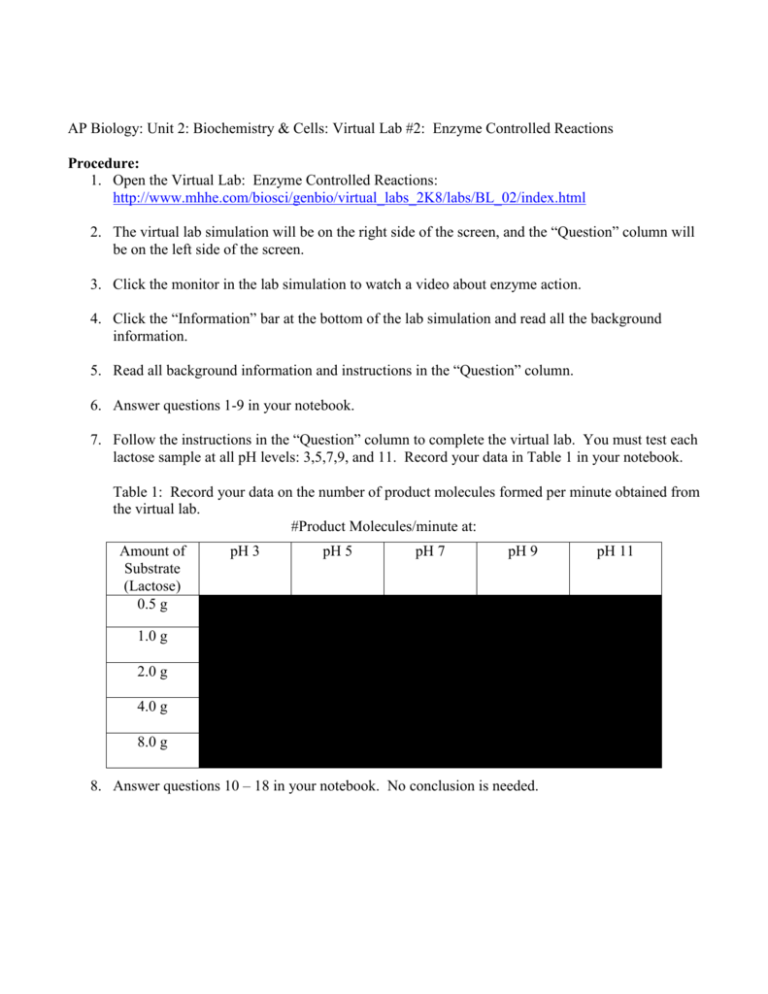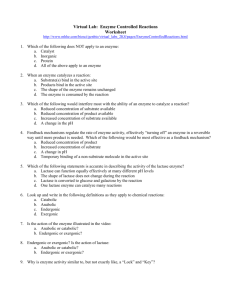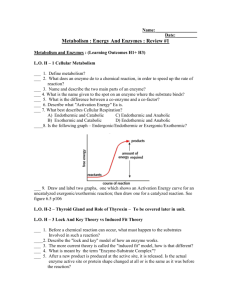Virtual Lab: Enzyme Controlled Reactions - NGHS
advertisement

AP Biology: Unit 2: Biochemistry & Cells: Virtual Lab #2: Enzyme Controlled Reactions Procedure: 1. Open the Virtual Lab: Enzyme Controlled Reactions: http://www.mhhe.com/biosci/genbio/virtual_labs_2K8/labs/BL_02/index.html 2. The virtual lab simulation will be on the right side of the screen, and the “Question” column will be on the left side of the screen. 3. Click the monitor in the lab simulation to watch a video about enzyme action. 4. Click the “Information” bar at the bottom of the lab simulation and read all the background information. 5. Read all background information and instructions in the “Question” column. 6. Answer questions 1-9 in your notebook. 7. Follow the instructions in the “Question” column to complete the virtual lab. You must test each lactose sample at all pH levels: 3,5,7,9, and 11. Record your data in Table 1 in your notebook. Table 1: Record your data on the number of product molecules formed per minute obtained from the virtual lab. #Product Molecules/minute at: Amount of Substrate (Lactose) 0.5 g pH 3 pH 5 pH 7 pH 9 1.0 g 2.0 g 4.0 g 8.0 g 8. Answer questions 10 – 18 in your notebook. No conclusion is needed. pH 11 Questions: 1. Which of the following does NOT apply to an enzyme: a. Catalyst b. Inorganic c. Protein d. All of the above apply to an enzyme 2. When an enzyme catalyzes a reaction: a. Substrate(s) bind in the active site b. Products bind in the active site c. The shape of the enzyme remains unchanged d. The enzyme is consumed by the reaction 3. Which of the following would interfere most with the ability of an enzyme to catalyze a reaction? a. Reduced concentration of substrate available b. Reduced concentration of product available c. Increased concentration of substrate available d. A change in the pH 4. Feedback mechanisms regulate the rate of enzyme activity, effectively “turning off” an enzyme in a reversible way until more product is needed. Which of the following would be most effective as a feedback mechanism? a. Reduced concentration of product b. Increased concentration of substrate c. A change in pH d. Temporary binding of a non-substrate molecule in the active site 5. Which of the following statements is accurate in describing the activity of the lactase enzyme? a. Lactase can function equally effectively at many different pH levels b. The shape of lactase does not change during the reaction c. Lactase is converted to glucose and galactose by the reaction d. One lactase enzyme can catalyze many reactions 6. Look up and write in the following definitions as they apply to chemical reactions: a. Catabolic b. Anabolic c. Endergonic d. Exergonic 7. Is the action of the enzyme illustrated in the video: a. Anabolic or catabolic? b. Endergonic or exergonic? 8. Endergonic or exergonic? Is the action of lactase: a. Anabolic or catabolic? b. Endergonic or exergonic? 9. Why is enzyme activity similar to, but not exactly like, a “Lock” and “Key”? 10. Describe the relationship between substrate concentration and the initial reaction rate of an enzyme-catalyzed reaction. Is this a linear relationship? What happens to the initial reaction rate as substrate concentration increases? 11. What substrate amount was required to achieve the maximum reaction rate? 12. At what pH level did the maximum reaction rate occur? 13. Why was there no increase in the reaction rate with 8.0 g. of substrate as compared to 4.0 g. of substrate? What would you need to add to see an increase in the reaction rate with 8.0 g. of substrate? 14. In the graph you created in the lab simulation with your data: a. What is represented by the green line? b. what is the optimal pH for lactase enzyme activity? 15. Consider only the experiment you conducted with 0.5 g. of lactose. a. What is the independent variable? b. What is the dependent variable? 16. The maximum rate of this reaction is 350 molecules product/minute. List two changes you could make in the experimental conditions or variables that would increase this reaction rate. Explain why each change you listed will increase the reaction rate. 17. Enzymes function most efficiently at the temperature of a typical cell, which is 37 degrees Celsius. Increases or decreases in temperature can significantly lower the reaction rate. What does this suggest about the importance of temperature-regulating mechanisms in organisms? Explain. 18. People with a lactose intolerance are able to take products such as Lactaid that contain the lactase enzyme with their meals. These products can be taken in pill form. Considering the fact that the pill form of the enzyme would have to travel through the person's stomach, what special consideration would the producer of this product need to be concerned about?




